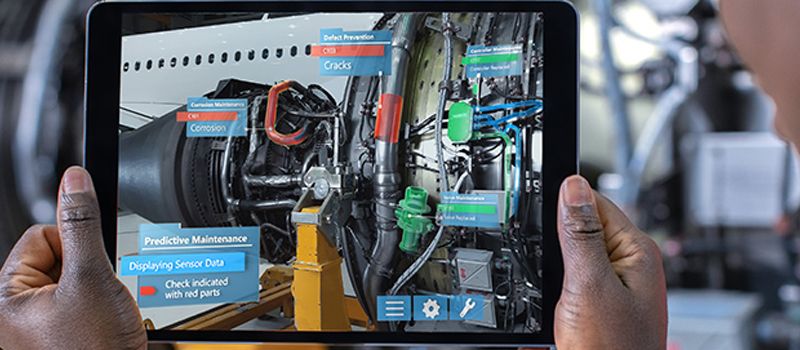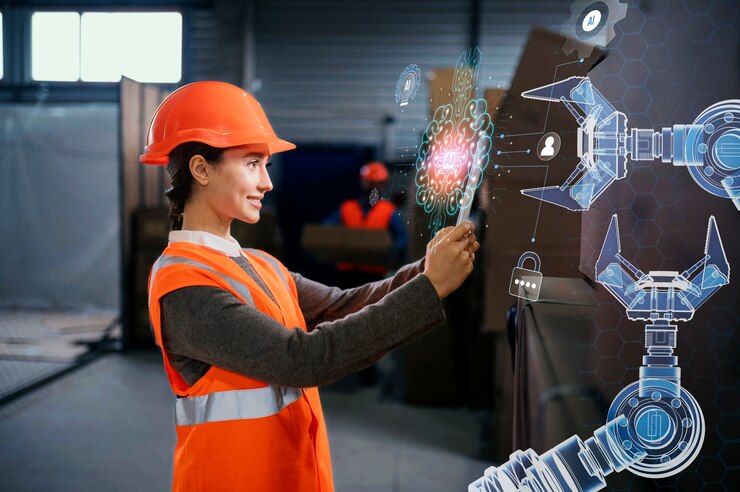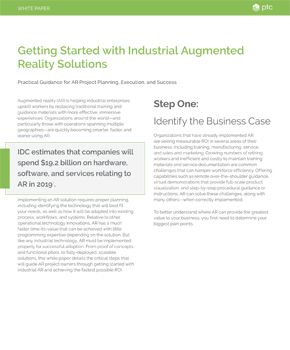
What is Industrial Augmented Reality (AR)?
Augmented reality (AR)is a technology which uses displays, cameras, different types of sensors, and specific software to augment the real-world environment with artificial perceptual experience, so it constitutes an interactive method of presenting relevant digital information in the context of the physical environment. Most AR applications use smart devices ( smart phones, tablets, and smart glasses) to convey digital information and graphics onto user’s real-world view.
AR is not a new concept, but with so many new developments in areas like computer vision, sensing technologies, data storage, and software technologies, it has become a much more practical solution for consumer, commercial, and industrial uses.
Augmented Reality in Industrial Cases
As mentioned before, AR technology has been around for quite some years, but only in recent years has the industrial world started to pay attention to this technology. Many in the industry, now use the term industrial augmented reality (IAR) for AR applications that support industrial processes and operations, because industrial augmented reality offers a better way to create and deliver easily consumable work instructions by overlaying digital content onto real-world work environments.
An obvious example of this is the automotive industry, where AR technologies are being used for helping drivers get speed, engine RPM, and other key information without having to take their eyes off the road.
One key benefit of AR is that it does not require dedicated hardware equipment. Advancements in Machine Learning and computer vision technology make it possible to build powerful AR applications for tablets and mobile phones, providing the industrial world with mobile solutions that are already becoming common and making it easier for industrial organizations to adopt AR technology.
Remote collaboration is one of the key areas where AR is proving to be very useful, as it enables a common scenario in industry, where industrial professionals must frequently collaborate with remote experts. The connected worker is a clear example of this, as it uses these technologies to remotely troubleshoot a malfunctioning asset in real time, or to train a new technician or even remotely guide a less experienced employee.
Also, manufacturers and OEMs that need to provide maintenance services for their equipment in different geographies can benefit enormously from remote augmented collaboration tools to reduce service costs and improve the profitability of these activities, as in some cases it even allows end users to fix issues themselves with remote guidance from the OEM’s experts.
Finally, AR can also be leveraged for machine monitoring, allowing to check a simulation of working machinery from a mobile device, as well as other information such as temperature, time of use, etc.
AR for Training
The manufacturing industry is facing an immediate crisis related to the depletion of skilled industrial workers. In this context, AR is proving to be an effective tool to help the industrial workforce thanks to remote augmented communication, and augmented operations.
Generally speaking, every industry needs to train the new recruits, and AR can be used to create hands-on and interactive training programs. Overall, AR has shown an improvement o 30% in new hire productivity, and a 25% reduction in training costs.
AR for Operations Management
AR is also gaining traction to simplify day-to-day operations in the industrial world. Assembly operations is a field where AR has gained the widest acceptance so far. AR instructions help assembly workers perform complex tasks more effectively, quickly, and with fewer errors in the automotive, semiconductor, and various other industries.
Another area where AR is increasingly used is Warehouse logistics, where AR applications are used to combine capabilities, such as image recognition, barcode scanning, indoor navigation, and integrating them with the warehouse management system.

Getting started with Industrial Augmented Reality Solutions: Steps to success
Implementing a successful AR strategy requires taking a few steps to ensuring the technology investment has immediate ROI. Here are a few recommended steps:
- Identify your pain points: to understand where AR can provide the greatest value to your business, you first need to determine your biggest pain points.
- Communicate and Collaborate to Maximize Success: identify champions and innovators in your company.
- Start small: AR experiences need to be simple, straightforward, and helpful to the end user. Iterating with a test audience can help you fine-tune any parts of the experience that are confusing or unclear.
- Training: online AR trainings and tutorials with your team members can accelerate your use case definition, ideation, and experience development. You can also build up internal AR expertise with face-to-face classroom style.
- Prioritize user experience: AR user experience should be intuitive, instructional, and easily reproduceable.
- Measure results: connect your results to immediate business value and allow you to better track progress over time.

